Discover 50 hidden attractions, cool sights, and unusual things to do in Greece. Don't miss out on these must-see attractions: Acropolis (Athens), Parthenon (Athens) or National Archaeological Museum (Athens).
Below, you can find the list of the most amazing places you should visit in Greece.
Table of Contents
Acropolis, Athens
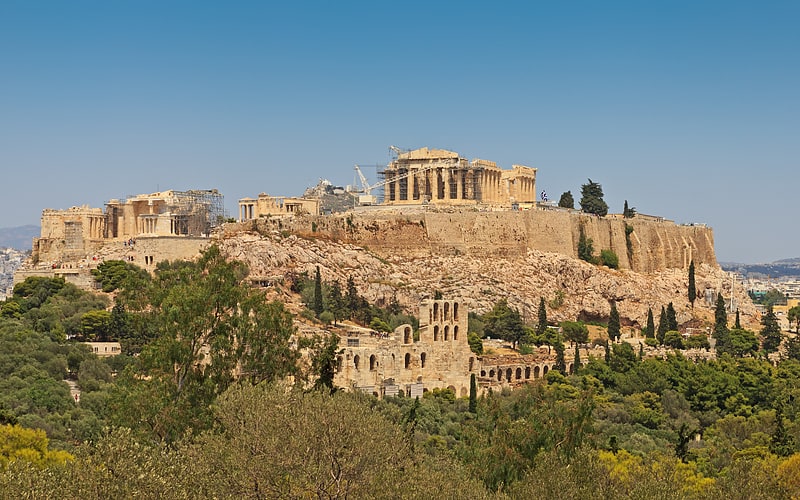
Also known as: Ακρόπολη Αθηνών
5th-century B.C. hilltop temple monument. The Acropolis of Athens is an ancient citadel located on a rocky outcrop above the city of Athens and contains the remains of several ancient buildings of great architectural and historical significance, the most famous being the Parthenon. The word acropolis is from the Greek words ἄκρον and πόλις. The term acropolis is generic and there are many other acropoleis in Greece. During ancient times the Acropolis of Athens was known also more properly as Cecropia, after the legendary serpent-man, Cecrops, the supposed first Athenian king.
While there is evidence that the hill was inhabited as far back as the fourth millennium BC, it was Pericles (c. 495–429 BC) in the fifth century BC who coordinated the construction of the buildings whose present remains are the site's most important ones, including the Parthenon, the Propylaea, the Erechtheion and the Temple of Athena Nike. The Parthenon and the other buildings were seriously damaged during the 1687 siege by the Venetians during the Morean War when gunpowder being stored in the Parthenon by the Ottomans was hit by a cannonball and exploded.[1]
Address: Ακρόπολη Αθηνών, Athens (Αθήνα 1)
Parthenon, Athens
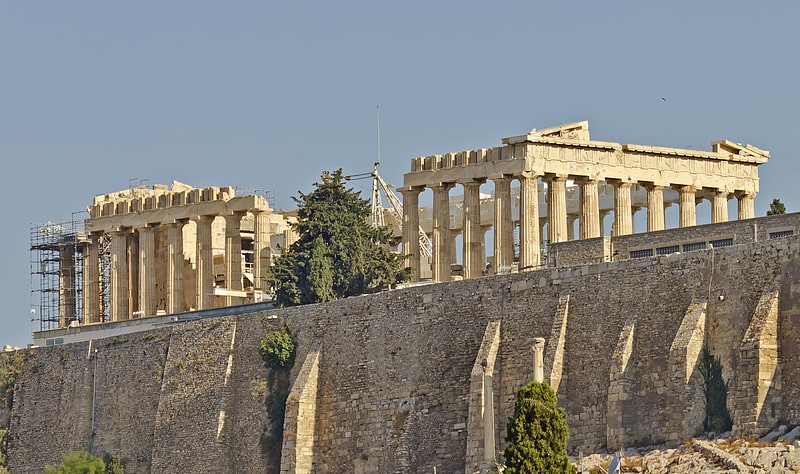
Also known as: Παρθενώνας
Iconic 5th BC Athenian temple ruins. The Parthenon is a former temple on the Athenian Acropolis, Greece, dedicated to the goddess Athena, whom the people of Athens considered their patroness. Construction started in 447 BC when the Delian League was at the peak of its power. It was completed in 438 BC, although decoration of the building continued until 432 BC. It is the most important surviving building of Classical Greece, generally considered the zenith of the Doric order.
For a time, it served as the treasury of the Delian League, which later on became the Athenian Empire. In the final decade of the 6th century AD, the Parthenon was converted into a Christian church dedicated to the Virgin Mary. After the Ottoman conquest, the Parthenon was turned into a mosque in the early 1460s. On 26 September 1687, an Ottoman ammunition dump inside the building was ignited by Venetian bombardment during a siege of the Acropolis. The resulting explosion severely damaged the Parthenon and its sculptures. From 1800 to 1803, The 7th Earl of Elgin removed some of the surviving sculptures, now known as the Elgin Marbles, reportedly with the permission of the Turks of the Ottoman Empire.
The Parthenon itself replaced an older temple of Athena, which historians call the Pre-Parthenon or Older Parthenon, that was demolished in the Persian invasion of 480 BC. Like most Greek temples, the Parthenon served a practical purpose as the city treasury. Its decorative sculptures are considered some of the high points of Greek art. The Parthenon is regarded as an enduring symbol of Ancient Greece, democracy and Western civilization, and one of the world's greatest cultural monuments. To the Athenians who built it, the Parthenon, and other Periclean monuments of the Acropolis, were seen fundamentally as a celebration of Hellenic victory over the Persian invaders and as a thanksgiving to the gods for that victory. Since 1975, numerous large-scale restoration projects have been undertaken to ensure the structural stability of the temple.[2]
Address: Ακρόπολη Αθηνών, Athens (Αθήνα 1)
National Archaeological Museum, Athens
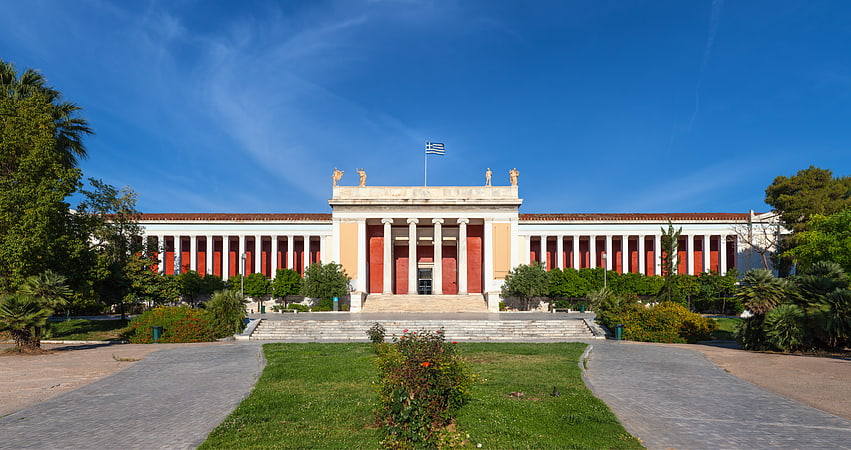
Also known as: Εθνικό Αρχαιολογικό Μουσείο
Ancient Greek art and archaeology museum. The National Archaeological Museum in Athens houses some of the most important artifacts from a variety of archaeological locations around Greece from prehistory to late antiquity. It is considered one of the greatest museums in the world and contains the richest collection of Greek Antiquity artifacts worldwide. It is situated in the Exarcheia area in central Athens between Epirus Street, Bouboulinas Street and Tositsas Street while its entrance is on the Patission Street adjacent to the historical building of the Athens Polytechnic university.[3]
Address: 28is Oktovriou 44, 106 82 Athina (Αθήνα 1)
Palace of the Grand Master of the Knights of Rhodes, Rhodes
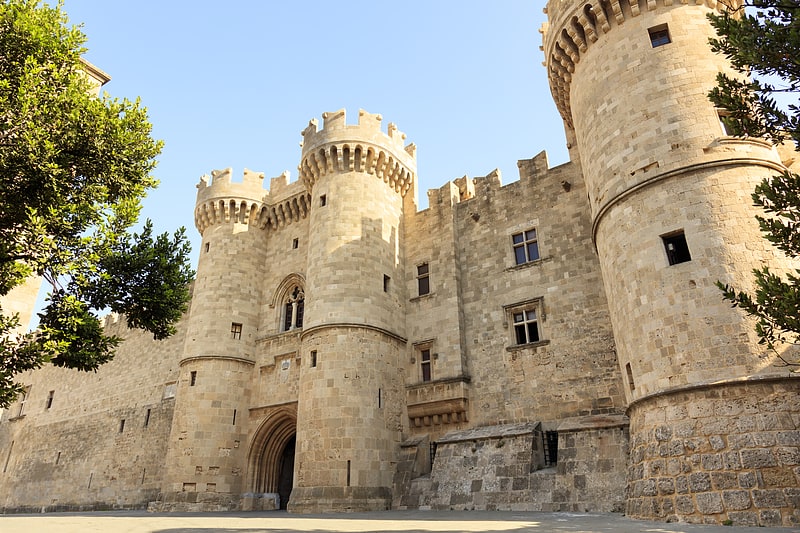
Also known as: Παλάτι του Μεγάλου Μαγίστρου
Rebuilt 14th-century castle and museum. The Palace of the Grand Master of the Knights of Rhodes, also known as the Kastello, is a medieval castle in the city of Rhodes, on the island of Rhodes in Greece. It is one of the few examples of Gothic architecture in Greece. The site was previously a citadel of the Knights Hospitaller that functioned as a palace, headquarters, and fortress.[4]
Address: Πλατεία Κλεοβούλου, 851 31 Ρόδος
White Tower, Thessaloniki
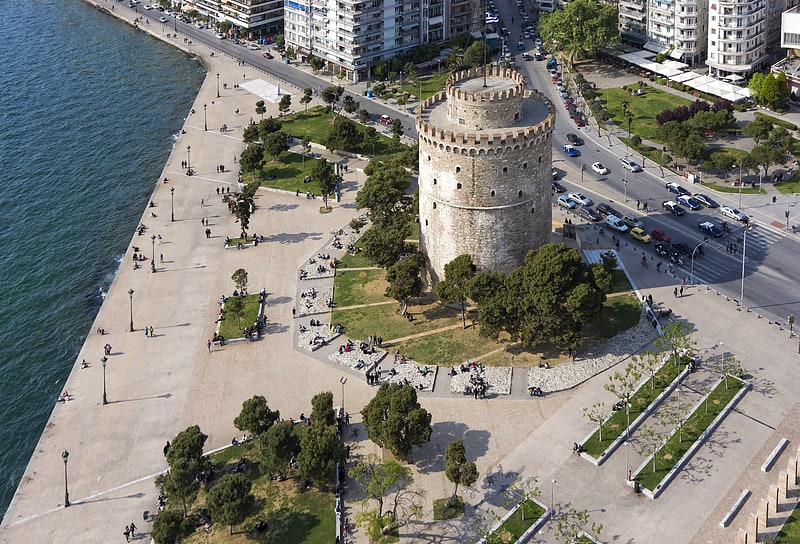
Also known as: Λευκός Πύργος
City history exhibit in landmark tower. The White Tower of Thessaloniki is a monument and museum on the waterfront of the city of Thessaloniki, capital of the region of Macedonia in northern Greece. The present tower replaced an old Byzantine fortification, known to have been mentioned around the 12th century, that the Ottoman Empire reconstructed to fortify the city's fortress after Sultan Murad II captured Thessaloniki in 1430. During the period of Ottoman rule, White tower became a notorious prison and scene of mass executions.
In 1912, Greece took again into custody the city of Thessaloniki and the White Tower was substantially remodeled and its exterior was whitewashed. White Tower has been adopted as the symbol of the city.[5]
Address: Πλατεία Λευκού Πύργου, 546 21 Θεσσαλονίκη (Θεσσαλονίκη)
Archaeological Museum of Thessaloniki, Thessaloniki

Also known as: Αρχαιολογικό Μουσείο Θεσσαλονίκης
Large, notable archaeological museum. The Archaeological Museum of Thessaloniki is a museum in Thessaloniki, Central Macedonia, Greece. It holds and interprets artifacts from the Prehistoric, Archaic, Classical, Hellenistic and Roman periods, mostly from the city of Thessaloniki but also from the region of Macedonia in general.[6]
Address: Manoli Andronikou 6, 546 21 Thessaloniki (Θεσσαλονίκη)
Hagios Demetrios, Thessaloniki

Also known as: Ιερός Ναός Αγίου Δημητρίου Θεσσαλονίκης
Church and remains of city's patron saint. The Church of Saint Demetrius, or Hagios Demetrios, is the main sanctuary dedicated to Saint Demetrius, the patron saint of Thessaloniki, dating from a time when it was the second largest city of the Byzantine Empire. It is part of the site Palaeochristian and Byzantine Monuments of Thessaloniki on the list of World Heritage Sites by UNESCO since 1988.[7]
Address: 83 Agiou Dimitriou, 546 33 Thessaloniki (Θεσσαλονίκη)
Knossos, Heraklion
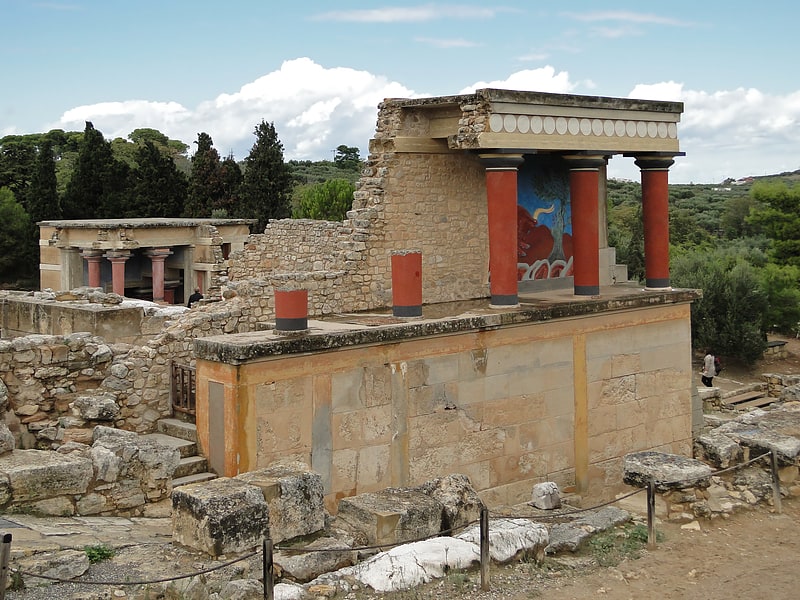
Also known as: Κνωσός
City in Crete, Greece. Knossos is the largest Bronze Age archaeological site on Crete and has been called Europe's oldest city.
Settled as early as the Neolithic period, the name Knossos survives from ancient Greek references to the major city of Crete. The palace of Knossos eventually became the ceremonial and political centre of the Minoan civilization and culture. The palace was abandoned at some unknown time at the end of the Late Bronze Age, c. 1380–1100 BC; the reason is unknown, but one of the many disasters that befell the palace is generally put forward.
In the First Palace Period (around 2000 BC), the urban area reached a size of as many as 18,000 people. In its peak, the palace and surrounding city boasted a population of 100,000 people shortly after 1700 BC.[8]
Archaeological Museum of Rhodes, Rhodes
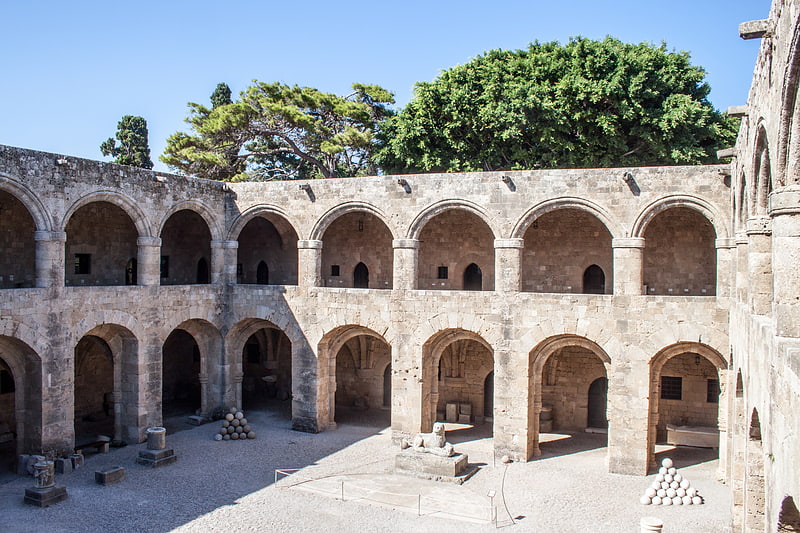
Also known as: Αρχαιολογικό Μουσείο Ρόδου
Museum in Rhodes, Greece. The Archaeological Museum of Rhodes is located in the Medieval City of Rhodes. The museum is housed in the monumental edifice that was the hospital of the Knights of Saint John. Construction of it was begun in 1440 and brought to completion in the time of the Grand Master d'Aubusson. The Museum contains various collections of archaeological artifacts from various parts of Rhodes and the neighbouring islands, including the Statue of the Crouching Aphrodite, which was inspired by a famous prototype work created by the sculptor Doidalsas in the 3rd century BC, and the Pyxis of the Fikellura type.
The museum also holds the Head of Helios, which was featured in 2011 on the album cover of Floral Shoppe by Macintosh Plus, and subsequently became famous for its association with the Vaporwave movement.[9]
Address: Akti Sachtouri 8, 851 00 Rodos
Delphi Archaeological Museum, Delphi
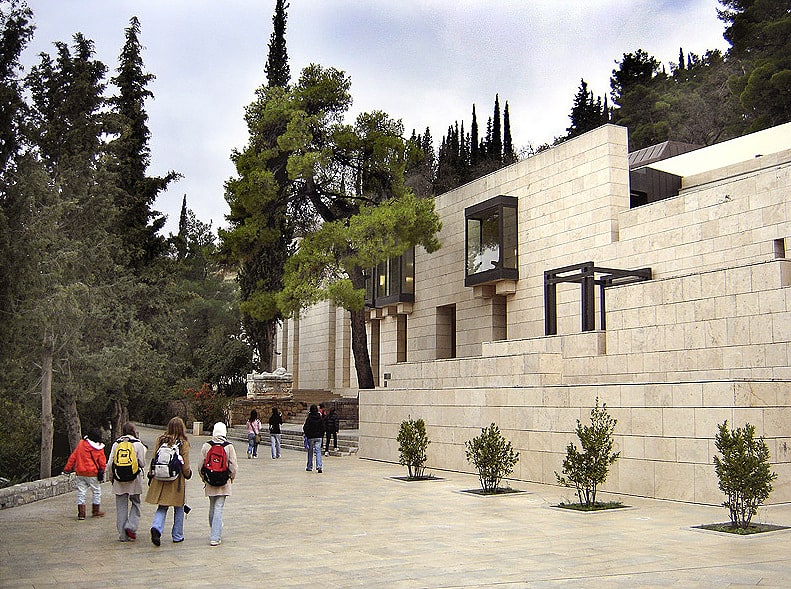
Also known as: Αρχαιολογικό Μουσείο Δελφών
Collections on the Delphic sanctuary. Delphi Archaeological museum is one of the principal museums of Greece and one of the most visited. It is operated by the Greek Ministry of Culture. Founded in 1903, it has been rearranged several times and houses the discoveries made at the Panhellenic sanctuary of Delphi, which date from the Late Helladic period to the early Byzantine era.
Organised in fourteen rooms on two levels, the museum mainly displays statues, including the famous Charioteer of Delphi, architectural elements, like the frieze of the Siphnian Treasury and ex votos dedicated to the sanctuary of Pythian Apollo, like the Sphinx of Naxos. The exhibition floor space is more than 2270m2, while the storage and conservation rooms (mosaics, ceramics and metals) take up 558m2. Visitors are also catered to by an entrance hall, a cafeteria and a gift shop.[10]
Address: Ethniki Odos Amfissas - Livadias, 330 54 Delphi
Heraklion Archaeological Museum, Heraklion
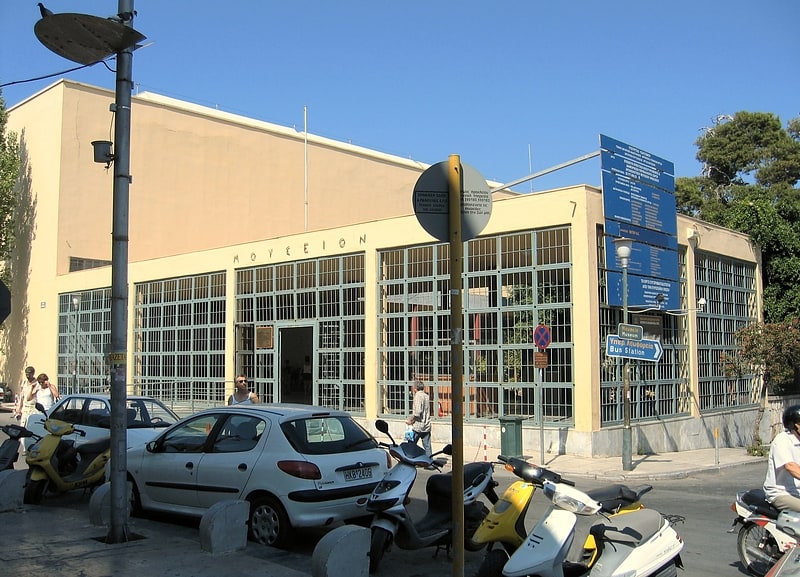
Also known as: Αρχαιολογικό Μουσείο Ηρακλείου
Museum for Cretan prehistory and history. The Heraklion Archaeological Museum is a museum located in Heraklion on Crete. It is one of the greatest museums in Greece and the best in the world for Minoan art, as it contains by far the most important and complete collection of artefacts of the Minoan civilization of Crete. It is normally referred to scholarship in English as "AMH", a form still sometimes used by the museum in itself.
The museum holds the great majority of the finds from Knossos and other Minoan sites in Crete.[11]
Address: Ξανθουδίδου 1, 712 02 Ηράκλειο
Old Fortress, Corfu Town
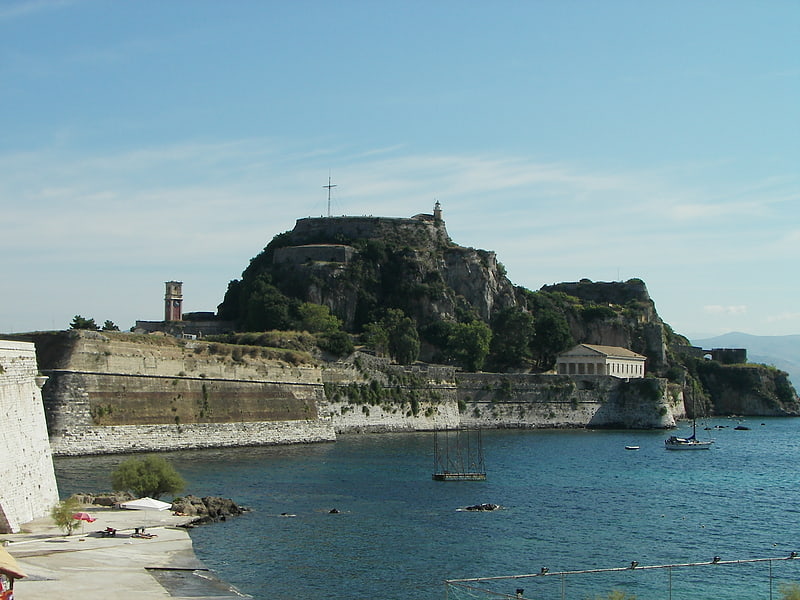
Fortress in Corfu, Greece. The Old Fortress of Corfu is a Venetian fortress in the city of Corfu. The fortress covers the promontory which initially contained the old town of Corfu that had emerged during Byzantine times.
Before the Venetian era the promontory, which lies between the Gulf of Kerkyra to the north and Garitsa Bay to the south, was defended by Byzantine fortifications which the Venetians largely replaced with fortifications of their own design. As part of their defensive plans the Venetians separated the promontory from the rest of the city of Corfu by creating the Contrafossa, a moat which is a sea channel connecting the Gulf of Kerkyra to the North with the Bay of Garitsa to the South, converting the citadel into an artificial island. The fort successfully repulsed all three major Ottoman sieges: the great siege of 1537, the siege of 1571 and the second great siege of Corfu in 1716.
The town of Corfu got its Western name from the twin peaks of the fortress ("Coryphe" in Greek).[12]
Address: Paleo Enetiko Frouno, Corfu Town
Spiros Boat Hire Barbati Beach, Corfu

Beach, Outdoor activities, Park
Aquarium, Rhodes
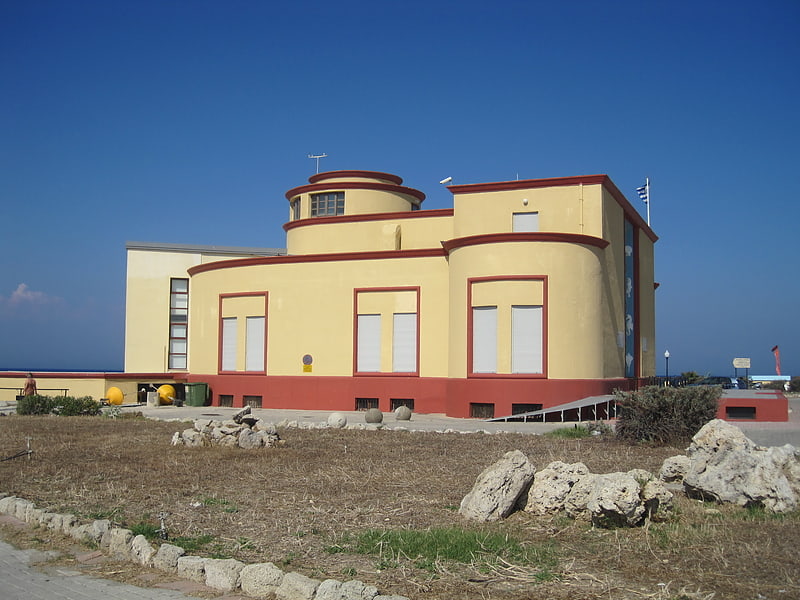
Also known as: Ενυδρείο Ρόδου
Small aquarium with unique architecture. The Aquarium of Rhodes is a research centre, aquarium and museum in Rhodes, Greece. It was built in the 1930s, when the island was under the Italian rule and is currently administered by the National Centre of Marine Research.[13]
Address: Kasou, 85100 Rhodes, Rhodes
Stadium at Olympia, Olympia
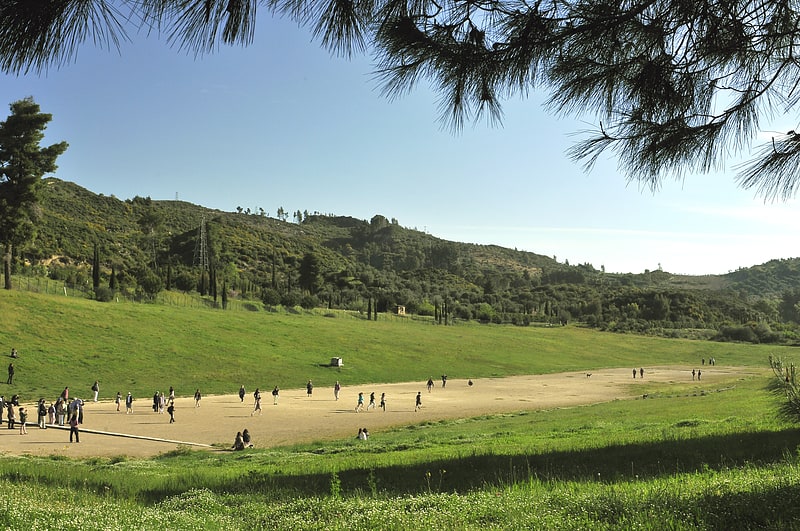
Also known as: Στάδιο αρχαίας Ολυμπίας
Sports venue in Greece. The stadium at the archaeological site of Olympia, Greece, is located to the east of the sanctuary of Zeus. It was the location of many of the sporting events at the Ancient Olympic Games.[14]
Knossos, Heraklion

Historical landmark in Knossos, Greece. Knossos, also romanized Cnossus, Gnossus, and Knossus, is the main Bronze Age archaeological site at Heraklion, a modern port city on the north central coast of Crete. The site was excavated and the palace complex found there partially restored under the direction of Arthur Evans in the earliest years of the 20th century. The palace complex is the largest Bronze Age archaeological site on Crete. It was undoubtedly the ceremonial and political centre of the Minoan civilization and culture.
Quite apart from its value as the center of the ancient Minoan civilization, Knossos has a place in modern history as well. It witnessed the fall of the Ottoman Empire and the enosis, or "unification," of Crete with Greece. It has been a center of Aegean art and archaeology even before its initial excavation. Currently a branch of the British School at Athens is located on its grounds. The mansion Evans had built on its grounds, Villa Ariadne, for the use of the archaeologists, was briefly the home of the Greek government in exile during the Battle of Crete in World War II. Subsequently, it was the headquarters for three years of the Nazi Germany's military governorship of Crete. Turned over to the Greek government in the 1950s, it has been maintained and improved as a major site of antiquities. Studies conducted there are ongoing.[15]
Achilleion, Corfu Town
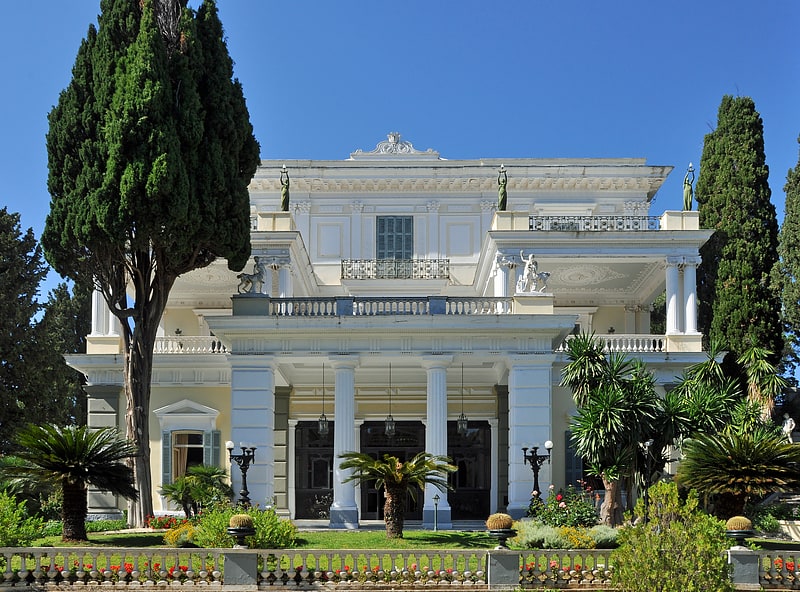
Also known as: Αχίλλειο
1800s palace with museum and gardens. Achilleion is a palace built in Gastouri on the Island of Corfu for the Empress Elisabeth of Austria, also known as Sisi, after a suggestion by the Austrian consul Alexander von Warsberg. Elisabeth was deeply saddened by the tragic loss of her only son, Crown Prince Rudolf of Austria following the Mayerling incident in 1889, and a year later she had this summer palace built as a refuge.
Achilleion is located about ten kilometres south of the city of Corfu and provides a panoramic view of the city to the north, and across the whole southern part of the island and with the Ionian Sea to the east.
The architectural style was designed to suggest an ancient palace of mythical Phaeacia. The motif centers on the hero Achilles of Greek mythology, from which the name is derived. Corfu was Elisabeth's favourite vacation destination and she wanted a palace to gratify her admiration for Greece, its language and its culture.
The property currently operates as a museum under the management of Hellenic Tourism Development Company, within the Greek National Tourism Organization.[16]
Archaeological Museum of Corfu, Corfu Town
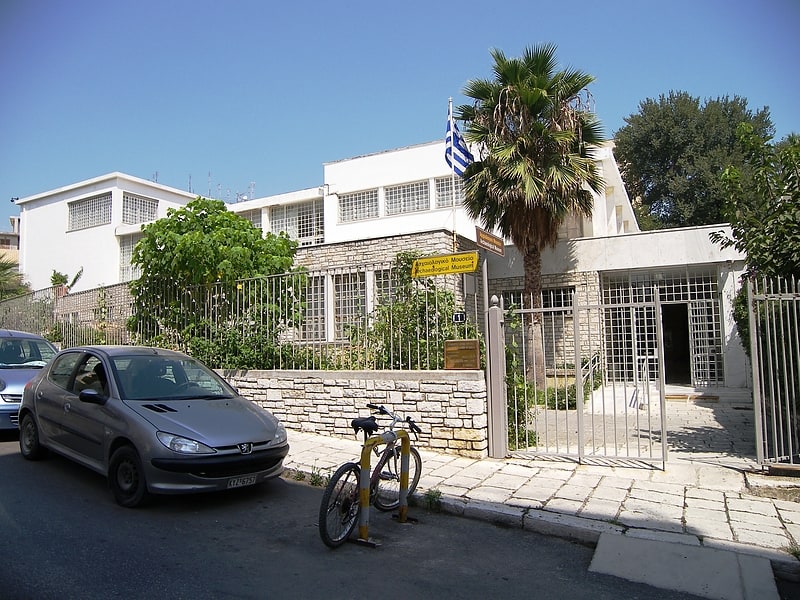
Also known as: Αρχαιολογικό Μουσείο Κέρκυρας
Archaeological museum with local objects. The Archaeological Museum of Corfu in Corfu, Greece was built between 1962 and 1965. The museum land was donated by the city of Corfu. Its initial purpose was to house the archaeological finds from the Temple of Artemis in Corfu. In 1994 it was expanded with the addition of two more exhibit halls that display the more recent finds at the ancient citadel of Corfu. It is located on 1 Vraila Armeni St.[17]
Address: Vrela Armeni 1, 491 00 Kerkira
Tiryns, Nafplio
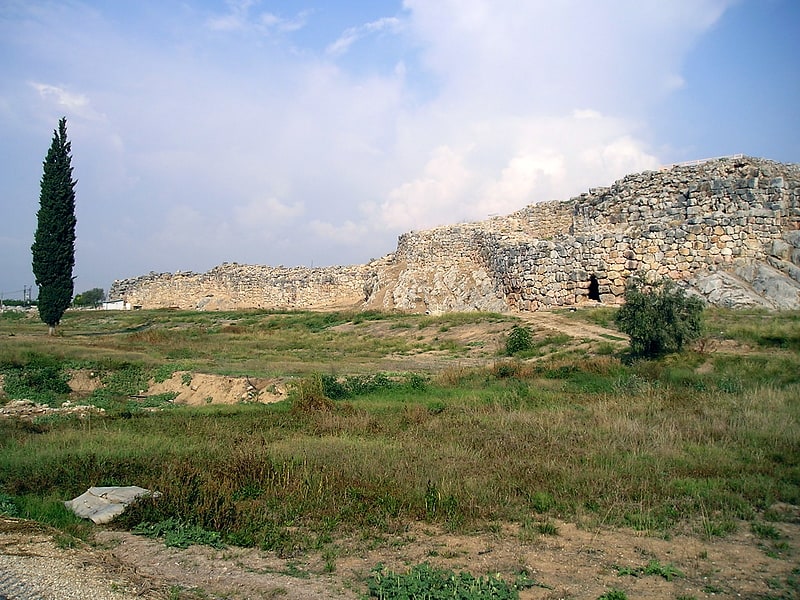
Also known as: Τίρυνθα
UNESCO-listed hill fort excavations. Tiryns or is a Mycenaean archaeological site in Argolis in the Peloponnese, and the location from which the mythical hero Heracles performed his Twelve Labours.
Tiryns was a hill fort with occupation ranging back seven thousand years, from before the beginning of the Bronze Age. It reached its height of importance between 1400 and 1200 BC, when it became one of the most important centers of the Mycenaean world, and in particular in Argolis. Its most notable features were its palace, its Cyclopean tunnels and especially its walls, which gave the city its Homeric epithet of "mighty walled Tiryns". Tiryns became associated with the myths surrounding Heracles, as the city was the residence of the hero during his labors, and some sources cite it as his birthplace.
The famous megaron of the palace of Tiryns has a large reception hall, the main room of which had a throne placed against the right wall and a central hearth bordered by four Minoan-style wooden columns that served as supports for the roof. Two of the three walls of the megaron were incorporated into an archaic temple of Hera.
The site went into decline at the end of the Mycenaean period, and was completely deserted by the time Pausanias visited in the 2nd century AD. This site, excavated by Heinrich Schliemann in 1884–1885, is the subject of ongoing excavations by the German Archaeological Institute at Athens and by the University of Heidelberg.
In 1300 BC the citadel and lower town had a population of 10,000 people covering 20–25 hectares. Despite the destruction of the palace in 1200 BC, the city population continued to increase and by 1150 BC it had a population of 15,000 people.
UNESCO designated Tiryns as a World Heritage Site in 1999.[18]
Address: Archeo Tirintha, Nafplio
Angelokastro, Corfu
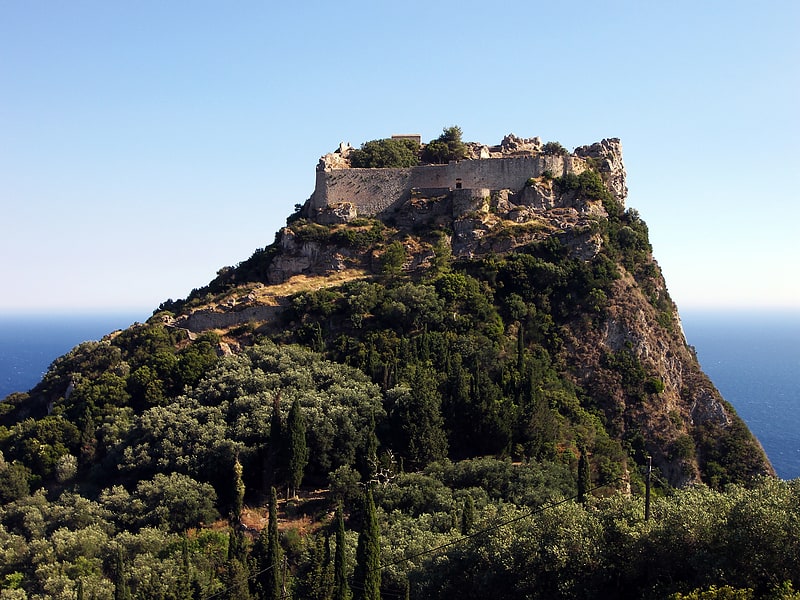
Also known as: Αγγελόκαστρο Κέρκυρας
Hilltop castle with art and water views. Angelokastro is a Byzantine castle on the island of Corfu, Greece. It is located at the top of the highest peak of the island's shoreline in the northwest coast near Palaiokastritsa and built on particularly precipitous and rocky terrain. It stands 1,000 ft on a steep cliff above the sea and surveys the City of Corfu and the mountains of mainland Greece to the southeast and a wide area of Corfu toward the northeast and northwest.
Angelokastro is one of the most important fortified complexes of Corfu. It was an acropolis which surveyed the region all the way to the southern Adriatic and presented a formidable strategic vantage point to the occupant of the castle.
Angelokastro formed a defensive triangle with the castles of Gardiki and Kassiopi, which covered Corfu's defences to the south, northwest and northeast.
The castle never fell, despite frequent sieges and attempts at conquering it through the centuries, and played a decisive role in defending the island against pirate incursions and during three sieges of Corfu by the Ottomans, significantly contributing to their defeat.
During invasions it helped shelter the local peasant population. The villagers also fought against the invaders playing an active role in the defence of the castle.
The exact period of the building of the castle is not known, but it has often been attributed to the reigns of Michael I Komnenos and his son Michael II Komnenos. The first documentary evidence for the fortress dates to 1272, when Giordano di San Felice took possession of it for Charles of Anjou, who had seized Corfu from Manfred, King of Sicily in 1267.
From 1387 to the end of the 16th century, Angelokastro was the official capital of Corfu and the seat of the Provveditore Generale del Levante, governor of the Ionian islands and commander of the Venetian fleet, which was stationed in Corfu.
The governor of the castle (the castellan) was normally appointed by the City council of Corfu and was chosen amongst the noblemen of the island.
Angelokastro is considered one of the most imposing architectural remains in the Ionian Islands, along with Kassiopi Castle, Gardiki Castle and the two Venetian Fortresses of Corfu City, the Citadel and the New Fort.[19]
Address: oltre il villaggio di Krini, Corfu
Arkadi Monastery, Rethymno
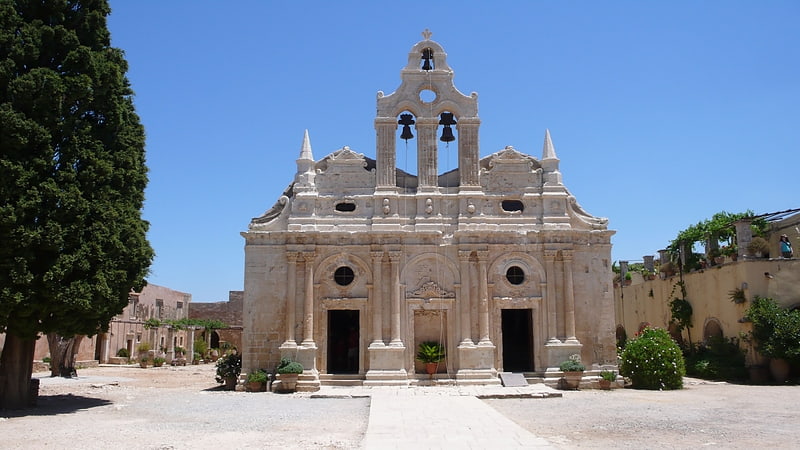
Also known as: Μονή Αρκαδίου
Historic monastery with a church. The Arkadi Monastery is an Eastern Orthodox monastery, situated on a fertile plateau 23 km to the southeast of Rethymnon on the island of Crete in Greece.
The current catholicon (church) dates back to the 16th century and is marked by the influence of the Renaissance. This influence is visible in the architecture, which mixes both Roman and baroque elements. As early as the 16th century, the monastery was a place for science and art and had a school and a rich library. Situated on a plateau, the monastery is well fortified, being surrounded by a thick and high wall.
The monastery played an active role in the Cretan resistance of Ottoman rule during the Cretan revolt of 1866. 943 Greeks, mostly women and children, sought refuge in the monastery. After three days of battle and under orders from the hegumen (abbot) of the monastery, the Cretans blew up barrels of gunpowder, choosing to sacrifice themselves rather than surrender.
The monastery became a national sanctuary in honor of the Cretan resistance. 8 November is a day of commemorative parties in Arkadi and Rethymno. The explosion did not end the Cretan insurrection, but it attracted the attention of the rest of the world.[20]
Address: Μονή Αρκαδίου, 741 00 Αμνάτος
Fortezza of Rethymno, Rethymno
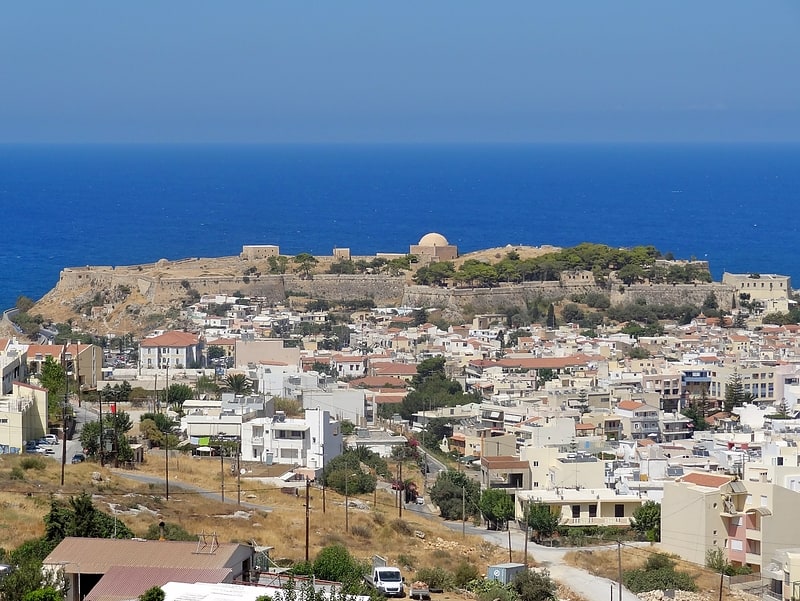
Also known as: Φορτέτζα Ρεθύμνου
Venetian fortress with city and sea views. The Fortezza is the citadel of the city of Rethymno in Crete, Greece. It was built by the Venetians in the 16th century, and was captured by the Ottomans in 1646. By the early 20th century, many houses were built within the citadel. These were demolished after World War II, leaving only a few historic buildings within the Fortezza. Today, the citadel is in good condition and is open to the public.[21]
Palamidi, Nafplio
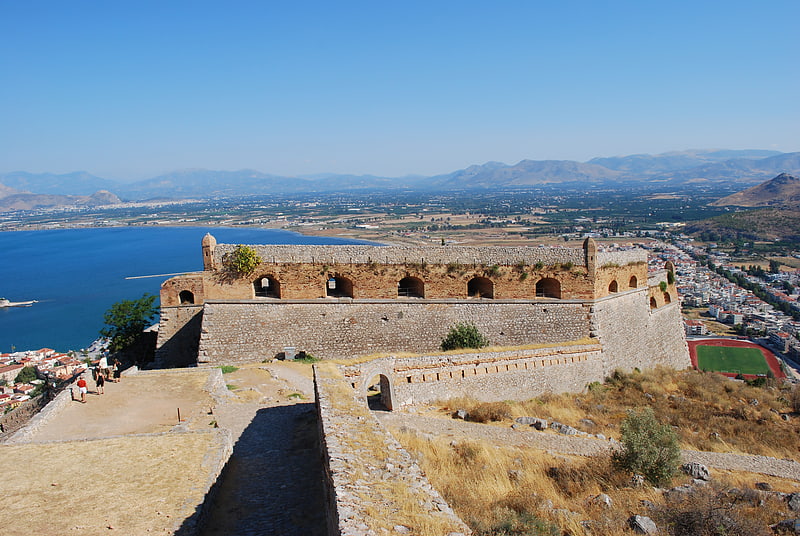
Also known as: Παλαμήδι
Early 18th-century bastioned citadel. Palamidi is a fortress to the east of the Acronauplia in the town of Nafplio in the Peloponnese region of southern Greece. Nestled on the crest of a 216-metre high hill, the fortress was built by the Venetians during their second occupation of the area.
The fortress was a very large and ambitious project, but was finished within a relatively short period from 1711 until 1714. It is a typical baroque fortress based on the plans of Venetian engineer Antonio Giancix (Antun Jančić) and built by French military engineer Pierre de la Salle. In 1715 it was captured by the Ottomans and remained under their control until 1822, when it was captured by the Greeks.
The eight bastions of the fortress were originally named after the Venetian provveditori. However, when it fell to the Ottoman Empire, the bastions were given Turkish names. Lastly, when the Greeks overthrew the Turks the bastions were renamed after ancient Greek leaders and heroes (Epaminondas, Miltiades, Leonidas, Phocion, Achilles, Themistocles. The two remaining bastions were named after St. Andrew (Agios Andreas) and the French Philhellene Robert who died in battle on the Acropolis of Athens. The "Miltiades," was used as a prison and among its walls was also held Theodoros Kolokotronis, hero of the Greek Revolution.
The fortress commands an impressive view over the Argolic Gulf, the city of Náfplio and the surrounding country. There are 913 steps in the winding stair from the town to the fortress. However, to reach the top of the fortress there are over one thousand. Locals in the town of Nafplion will say there are 999 steps to the top of the castle, and specials can be found on menus that incorporate this number to catch a tourist's eye.[22]
Address: Eikostis Pemptis Martiou, 211 00 Nafplio
Archaeological Museum of Olympia, Olympia
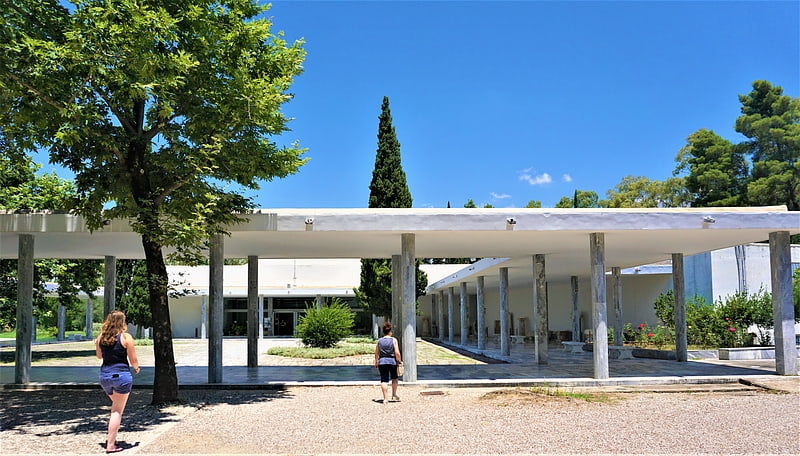
Also known as: Αρχαιολογικό Μουσείο Ολυμπίας
Showcase for finds from ancient Olympia. The Archaeological Museum of Olympia is one of the principal museums of Greece, located in Olympia. It is overseen by the Ministry of Culture and Sports, and, as of 2009, is directed by Georgia Xatzi. When the original building was completed and opened in 1882, it was the first museum in Greece outside of Athens.
The museum houses discoveries from the surrounding area, including the site of the Ancient Olympic Games. The collection includes objects produced and used in the area from prehistory to its time under Roman rule. The principal pieces in the museum are Hermes and the Infant Dionysus (attributed to Praxiteles), some objects from the Temple of Zeus, the Nike of Paionios, as well as an oenochoe that belonged to Phidias. The extent of its bronze collection makes it one of the most important in the world.
Today, the museum is housed in two buildings: the principal building with twelve rooms for exhibitions, organized both around themes and ages of the objects. The other building is dedicated to the museum store, and is separate from the main structure, located on the path to the archaeological site.[23]
Sunset Beach, Corfu
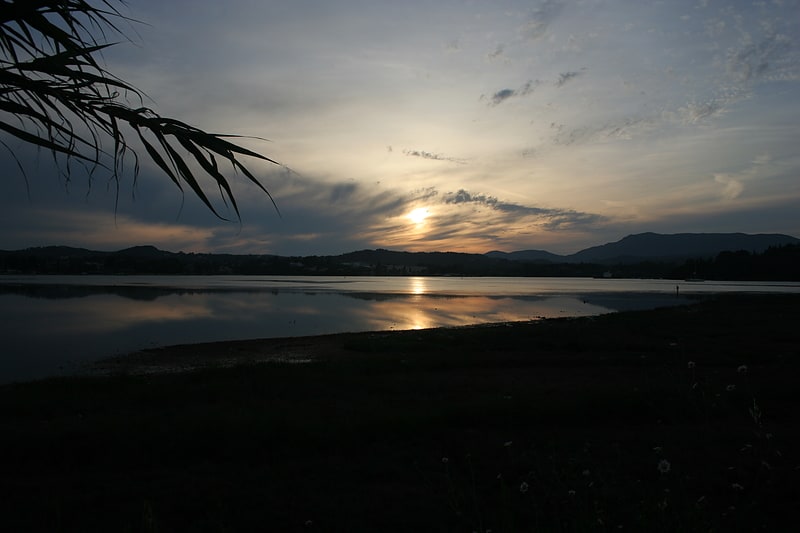
Beach
Archaeological Museum of Chania, Chania
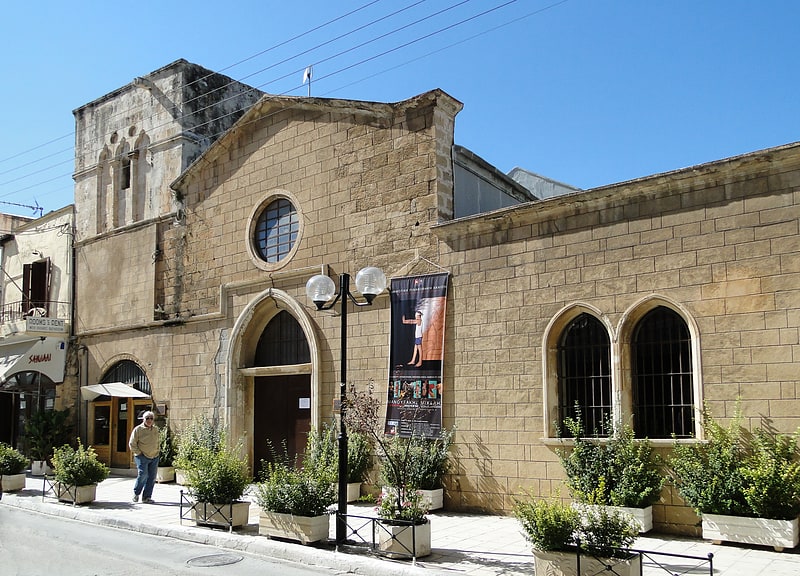
Museum displaying regional artifacts. The Archaeological Museum of Chania is a museum that was located in the former Venetian Monastery of Saint Francis at Chalidon Street, Chania, Crete, Greece. It was established in 1962. In 2020 this location closed and the museum will be relocated to a new building in Halepa with reopening scheduled for June 2021.[24]
Address: 21 Chalidon Street, Chania
Treasury of the Massaliots, Delphi
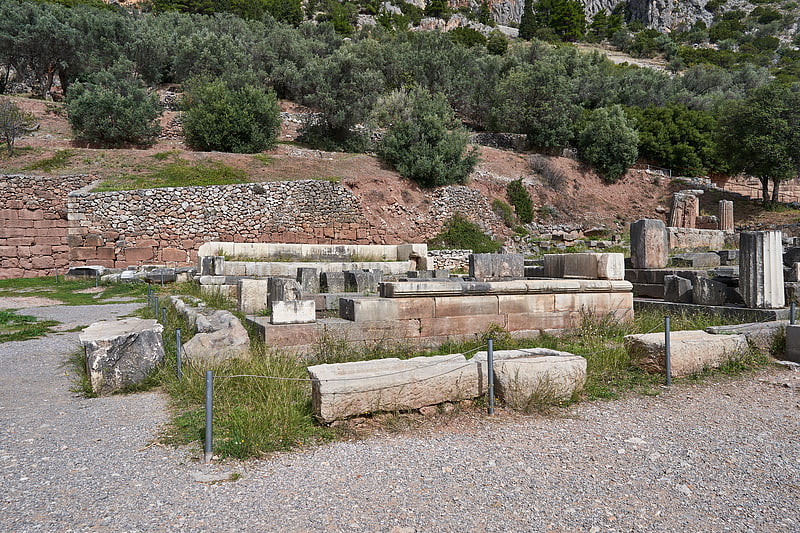
The treasury of the Massaliots was situated in the Sanctuary of Athena Pronaea. It looked like a small temple in antis with two columns on the façade; it was constructed of Parian marble and among its remarkable features were its "Aeolian" capitals.[25]
Sicyonian Treasury, Delphi
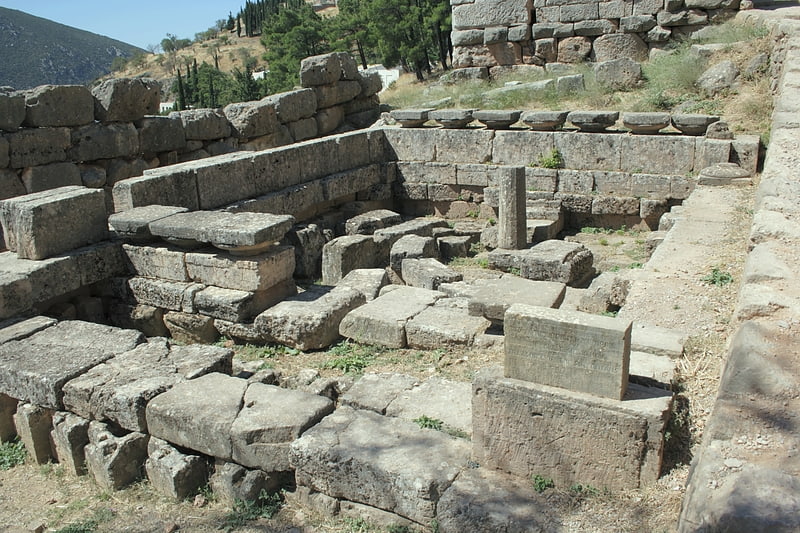
The Treasury of the Sicyonians is one of the buildings within the sanctuary of Apollo in Delphi. It has a long and complicated history. The treasury itself replaced two former buildings, namely the tholos and the monopteros, built by the same city at an earlier stage within the 6th century. The earlier buildings were related to the Orthagorids of Sicyon and particularly to the victories of the tyrant Cleisthenes of Sicyon in the course of the First Sacred War and their replacement probably marks the change in tide in Sicyonian politics.[26]
Porto Vromi Maries Cruises & Fun, Zakynthos
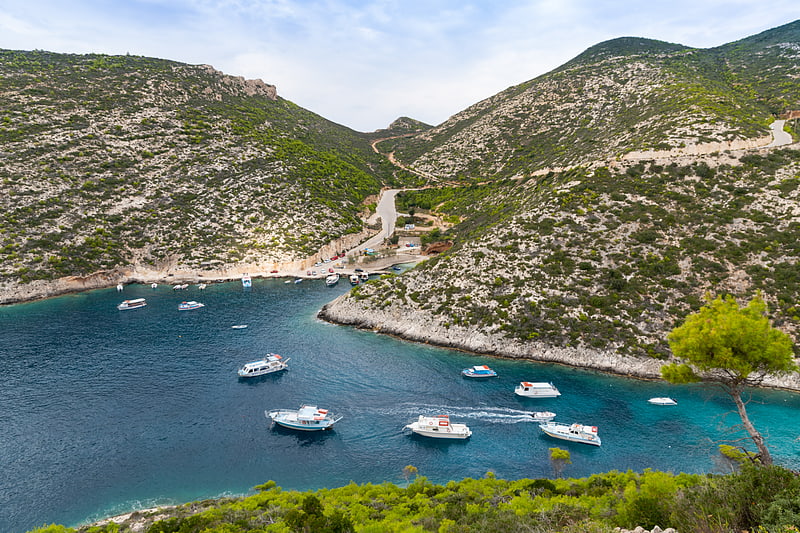
Beach
Address: Porto Vromi Maries, Zakynthos
Archaeological Museum of Naxos, Naxos
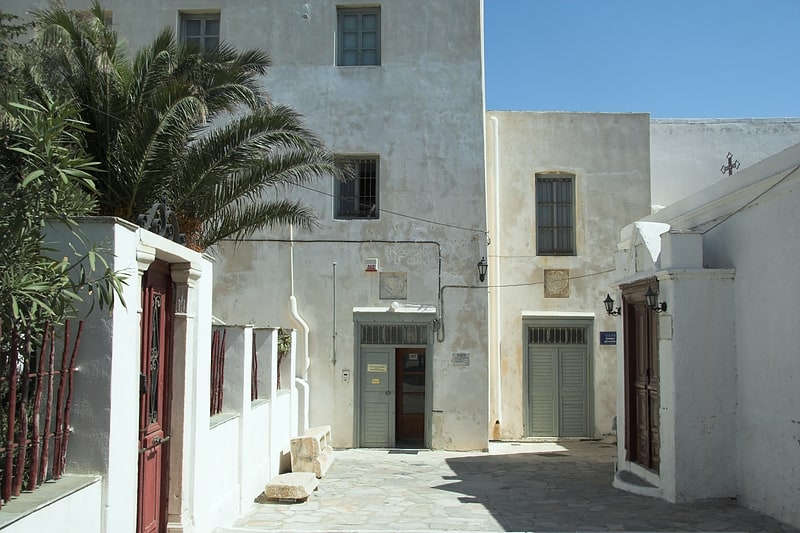
Collection of prehistoric artifacts. Archaeological Museum of Naxos is a museum in Naxos Greece.
This newly declared historical monument is located in a Venetian building, built some time between 1600 and 1800 for the Jesuit school established in 1700, later becoming the Archaeological Museum in 1972.
The museum houses finds from the Early Cycladic period including figurines from Naxos itself, Kato Kouphonisi and Keros, from the Late Mycenaean period including stirrup jars and other grave goods from chamber tombs and other graves from the Kamini mound and Aplomata. A smaller area is given over to finds from the Geometric Period and later finds, including sculpture from all periods of Naxos' history.
With effect from 07 January 2019, it is open from 08.00 to 15.30 daily, except Tuesdays.[27]
Address: Nasso e Piccole Cicladi, 843 00 Naxos Town
Archaeological Museum of Mykonos, Mykonos
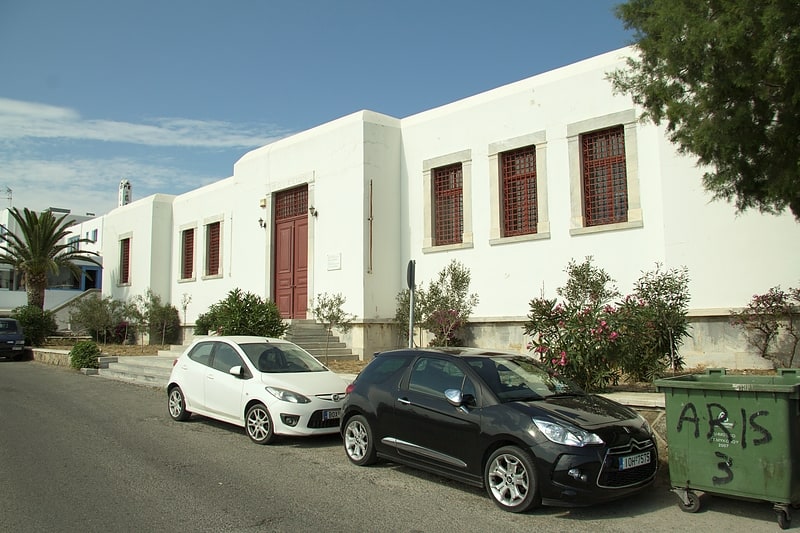
Exhibits of ancient pottery and sculpture. The Archaeological Museum of Mykonos is a museum, in Mykonos, in Greece. Was built in 1905 to house the findings from the Putrefaction Pit of 425/426 BC, discovered in 1898 on the islet of Rheneia by D. Stavropoulos. It is one of the oldest museums in Greece and was designed by Alexandros Lykakis and funded by the Ministry of Education and the Archaeological Society of Athens. The land as donated by the Municipality of Mykonos. Its collections include exhibits dating from the Prehistoric to the Hellenistic period.
The original Neoclassical building underwent refurbishments and expansions in the 1930s and 1960s and the large eastern room was added in 1972. The museum contains artefacts from the neighbouring island Rhenia, including 9th- to 8th-century BC ceramic pottery from the Cyclades and 7th- to 6th-century BC works from other areas in the Aegean. Its most famous item is the large vase produced in Tinos, showing scenes from the fall of Troy.[28]
Archaeological Museum of Delos, Delos
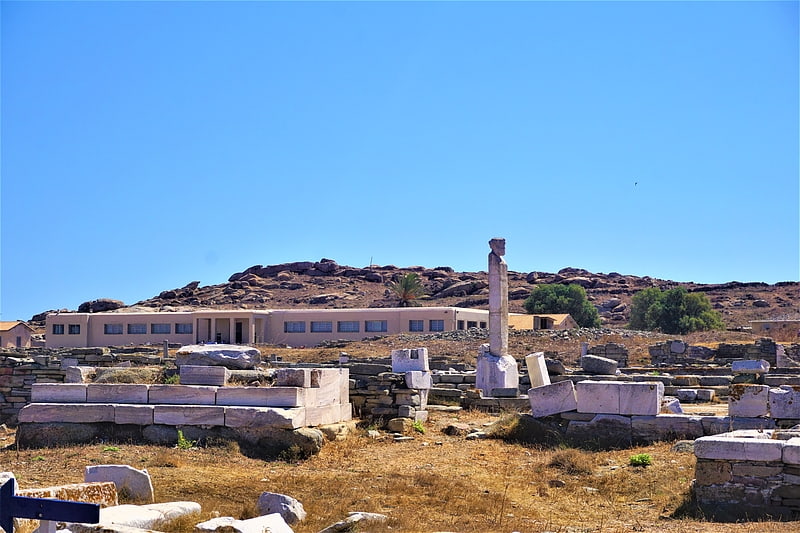
Also known as: Αρχαιολογικό Μουσείο Δήλου
Museum in Delos, Greece. The Archaeological Museum of Delos is a museum on the island of Delos, near Mykonos in the South Aegean, Greece. It is noted for its extensive collection of statues unearthed in the surrounding area of the ancient site, which has been declared a UNESCO World Heritage Site. Although the museum has a considerable collection, it does not contain all of the items found in Delos: a large quantity are on display in Athens at the National Archaeological Museum.[29]
Monolithos, Santorini
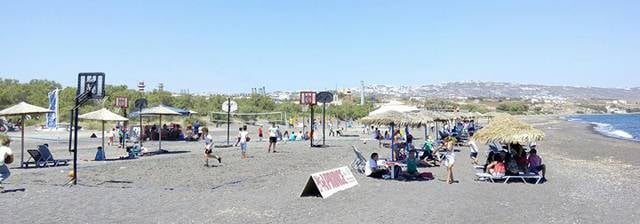
Beach, Outdoor activities, Park
Neptune Hotels - Resort, Kos
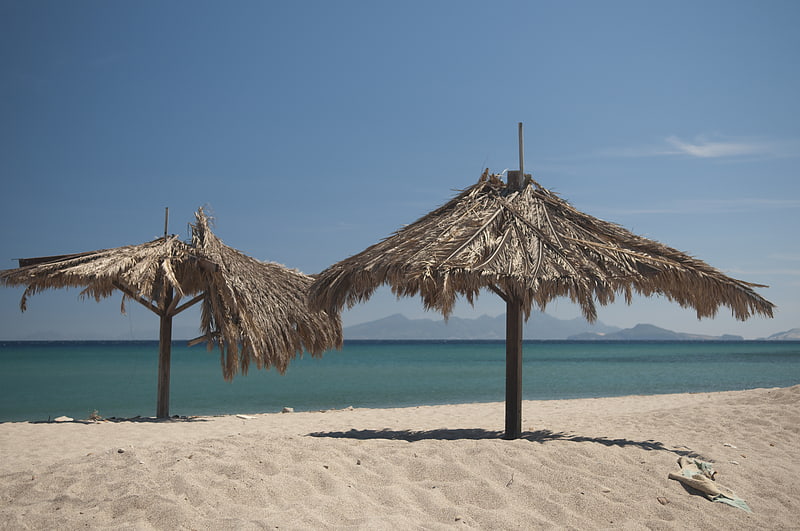
Beach
Address: Mastichari, 85302 Kos, Dhodhekanisos, Kos
Archaeological Museum of Piraeus, Piraeus
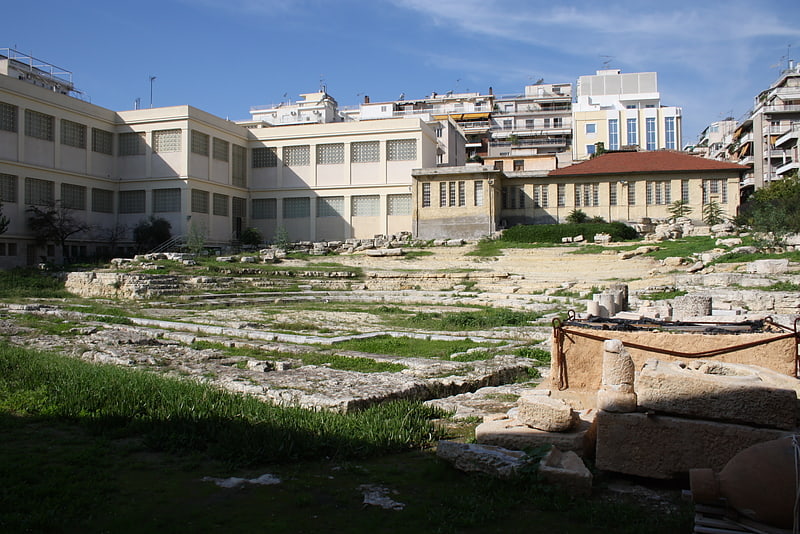
Also known as: Αρχαιολογικό Μουσείο Πειραιά
Prehistoric artifacts and ancient statues. The Archaeological Museum of Piraeus contains mainly sculptures, discovered in Piraeus and in the area of the Attic coast from Bronze Age to Roman times,[30]
Address: 31 Trikoupi Charilaou, 185 36 Piraeus
Peloponnesian Folklore Foundation, Nafplio
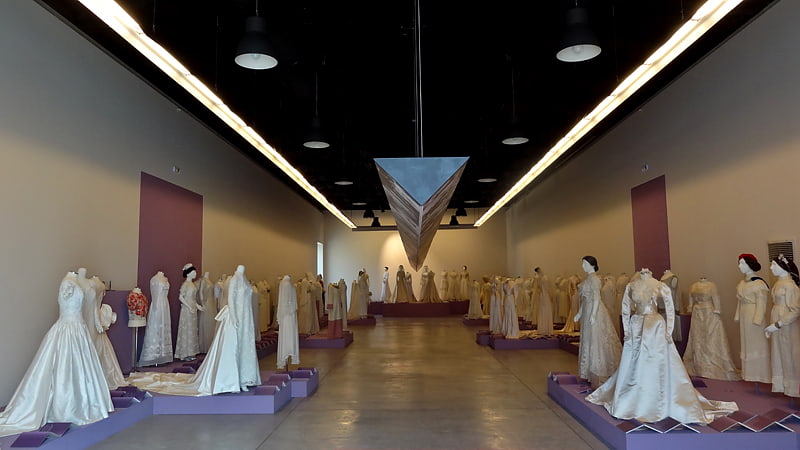
Also known as: Πελοποννησιακό Λαογραφικό Ίδρυμα
Cultural institute. The Peloponnesian Folklore Foundation ‘Vas. Papantoniou’ or PFF is a nonprofit cultural institution and museum based in Nafplion, Greece. It was founded in 1974 by the folklorist and scenic designer Ioanna Papantoniou in memory of her father Vasilios Papantoniou. The aim of PFF is the research, preservation, study and presentation of the material culture of the Greeks.[31]
Address: Vasileos Alexandrou 1, 21100 Nafplio
Archaeological Museum of Rethymno, Rethymno
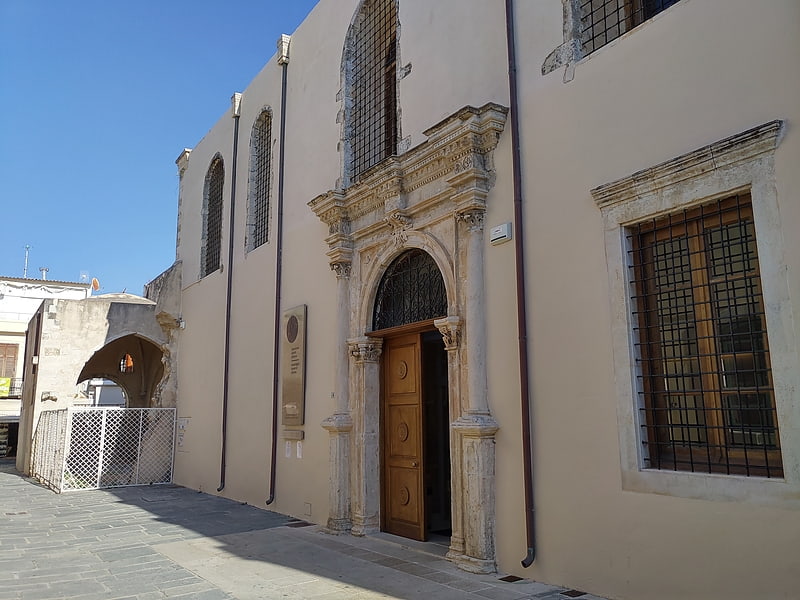
Museum in Rethymno, Greece. The Archaeological Museum of Rethymno is a museum in Rethymno, Crete, Greece.[32]
Archaeological Museum of Milos, Milos
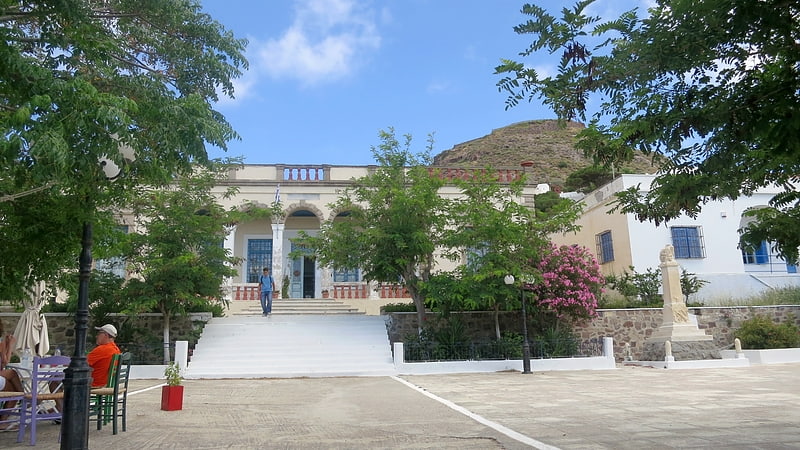
Museum in Plaka, Milos, Greece. The Archaeological Museum of Milos is a museum, in Plaka, Milos on Milos, in Greece. Its collections include exhibits dating from the late Neolithic to the Byzantine period. The unique is collection of ancient Cycladic art, especially numerous findings from Phylakopi on Milos, from early Bronze Age to the late Bronze Age. The best pieces from Phylakopi are in the Ashmolean Museum, in the British Museum and in the National Museum of Athens and elsewhere around the world.
The museum is housed since 1985 in a neo-classical building dating from 1870 on the main square in Plaka. In the porch of the building and on the courtyard is lapidary with torsos from the late antiquity.[33]
Nautical Museum of Crete, Chania

Also known as: Ναυτικό Μουσείο Κρήτης
Exhibits on Crete's naval history. The Nautical Museum of Crete is a museum in Chania, Crete, Greece. Its collection includes models of ships, nautical instruments, painting, historical photographs and war relics. The material is classified chronologically, starting from the Bronze Age up to our times.[34]
Address: Ακτή Κουντουριώτη, Chania
Temple of Hera, Olympia
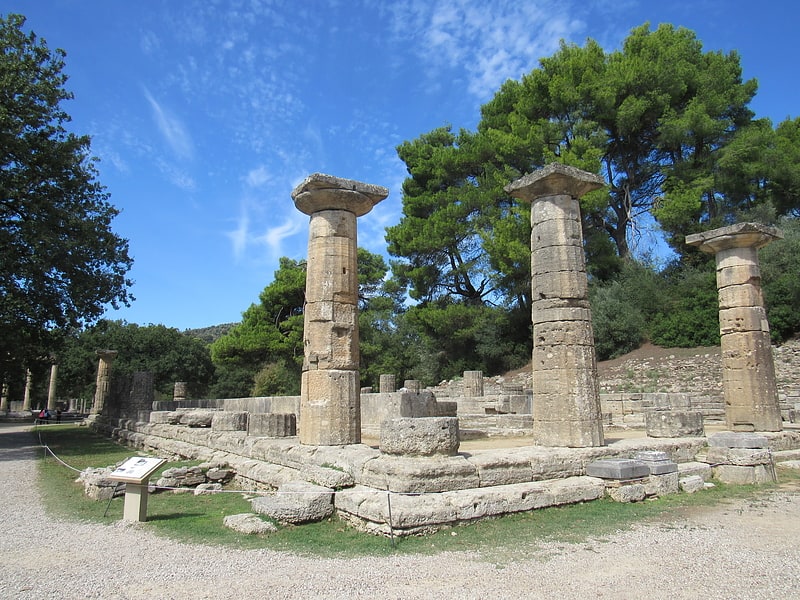
Also known as: Ηραίον Ολυμπίας
Historical landmark in Greece. The Temple of Hera, or Heraion, is an ancient Archaic Greek temple at Olympia, Greece, that was dedicated to Hera, queen of the Greek gods. It was the oldest temple at Olympia and one of the most venerable in all Greece. It was originally a joint temple of Hera and Zeus, chief of the gods, until a separate temple was built for him. It is at the altar of this temple, which is oriented east-west, that the Olympic flame is lit and carried to all parts of the world. The torch of the Olympic flame is lit in its ruins to this day. The temple was built in approximately 590 BC, but was destroyed by an earthquake in the early 4th century CE.[35]
Lion Gate, Mycenae
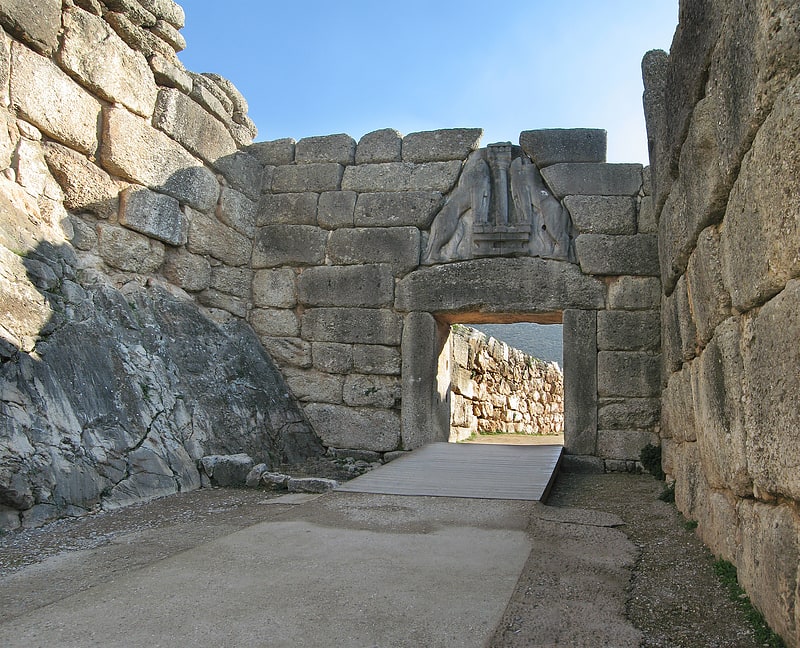
Also known as: Πύλη των Λεόντων
Lion Gate is the popular modern name for the main entrance of what was the Bronze Age citadel of Mycenae in southern Greece. It was erected during the thirteenth century BC, around 1250 BC, in the northwestern side of the acropolis. In modern times, it was named after the relief sculpture of two lionesses in a heraldic pose that stands above the entrance.
The gate is the sole surviving monumental piece of Mycenaean sculpture, as well as the largest surviving sculpture in the prehistoric Aegean. It is the only monument of Bronze Age Greece to bear an iconographic motif that survived without being buried underground. It is the only relief image that was described in the literature of classical antiquity, such that it was well known prior to modern archaeology.[36]
Makra Stoa, Piraeus

The Makra Stoa is an archaeological site which formed part of the urban fabric of the ancient city of Piraeus in Athens, Greece[37]
Agios Stefanos, Mykonos
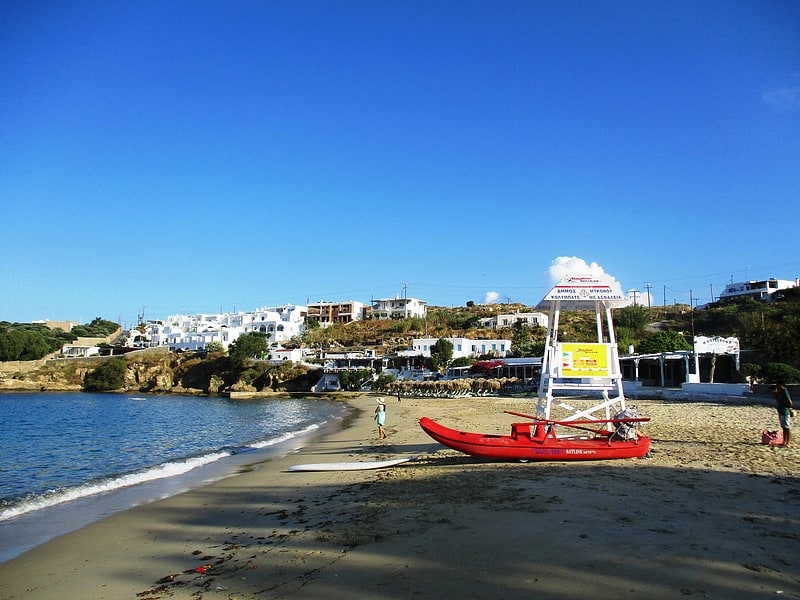
Beach in Greece. Agios Stefanos is a sandy beach next to Tourlos, the new harbor of Mykonos. It is located 3.5 km from Mykonos town. Agios Stefanos attracts a large number of tourists each summer since there are many facilities close to the beach. Visitors will find there sunbeds, umbrellas and most of water sports available at other Mykonian beaches as well. There are also many hotels that offer accommodation, while on the beach there is a great variety of restaurants and cafes to keep anyone satisfied. The beach can be reached via taxi, private vehicle or regular bus service from Mykonos town.[38]
Address: Παραλία Αγίου Στεφάνου, 846 00 Μύκονος
Rio–Antirrio Bridge, Patra
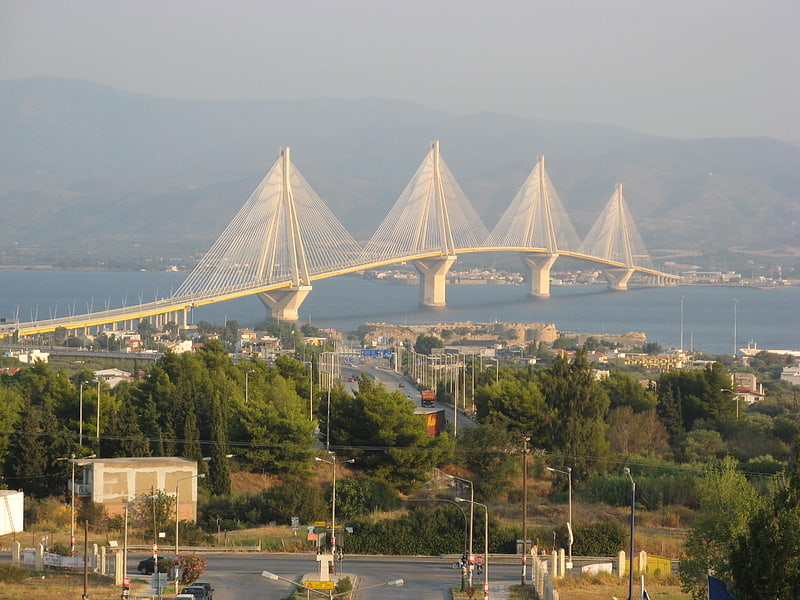
Also known as: Γέφυρα Ρίου – Αντιρρίου
Cable-stayed bridge in Greece. The Rio–Antirrio Bridge, officially the Charilaos Trikoupis Bridge, is one of the world's longest multi-span cable-stayed bridges and longest of the fully suspended type. It crosses the Gulf of Corinth near Patras, linking the town of Rio on the Peloponnese peninsula to Antirrio on mainland Greece by road. It opened one day before the Athens 2004 Summer Olympics, on 12 August 2004, and was used to transport the Olympic flame.[39]
Electric Railways Museum of Piraeus, Piraeus
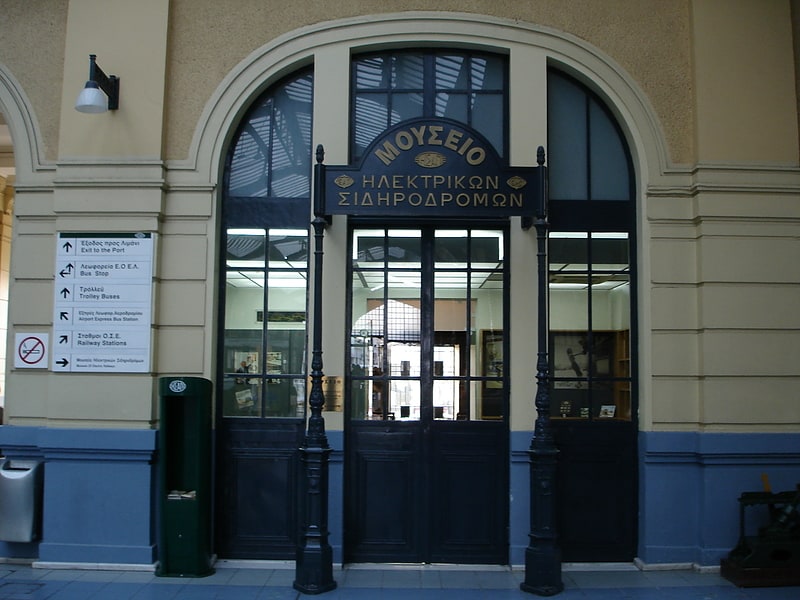
Also known as: Μουσείο Ηλεκτρικών Σιδηροδρόμων
Museum in Piraeus, Greece. The Electric Railways Museum of Piraeus is a railway museum in Piraeus, Greece. The museum was established in 2005 in the space of the former Post Office in Piraeus railway station. The museum displays a collection of small size items, photographs and documents related to the history of Athens-Piraeus Railway, Hellenic Electric Railways, Piraeus-Perama light railway, Piraeus Harbour tramway, Electric Transport Company and Athens-Piraeus Electric Railways. The museum also owns a collection of approximately 2000 small and medium size items and 3000 books, leaflets and other documents, currently in storage.[40]
Tree of Hippocrates, Kos
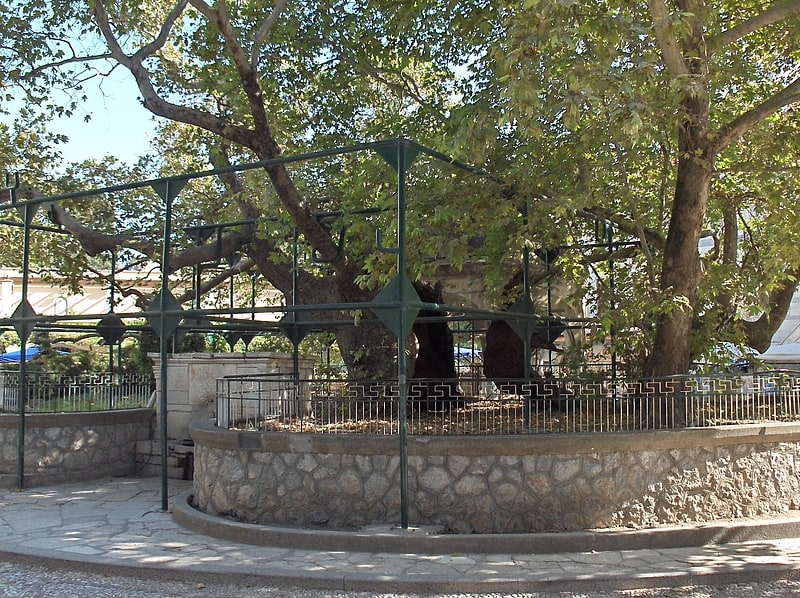
Also known as: Πλάτανος του Ιπποκράτη
Historical landmark in Kos, Greece. The Tree of Hippocrates is the plane tree under which, according to legend, Hippocrates of Kos taught his pupils the art of medicine. Paul of Tarsus purportedly taught here as well. The Platanus in Kos is an oriental plane, with a crown diameter of about 12 metres, said to be the largest for a plane tree in Europe.
Hippocrates' tree resides on the Platía Platanou (or "Square of the Platane"), in front of the Castle of Knights and next to the Gazi Hassan Mosque (erected in 1776) in the centre of Kos town. The current tree is only about 500 years old, but may possibly be a descendant of the original tree which allegedly stood there 2400 years ago, in Hippocrates' time. The tree has become hollowed out over the years, and some branches are supported by metal scaffolding. Next to the tree is a white tap with engravings in the Arabic language, also built by the Turkish Governor Gazi Hassan.[41]
Archaeological Museum of Thera, Santorini
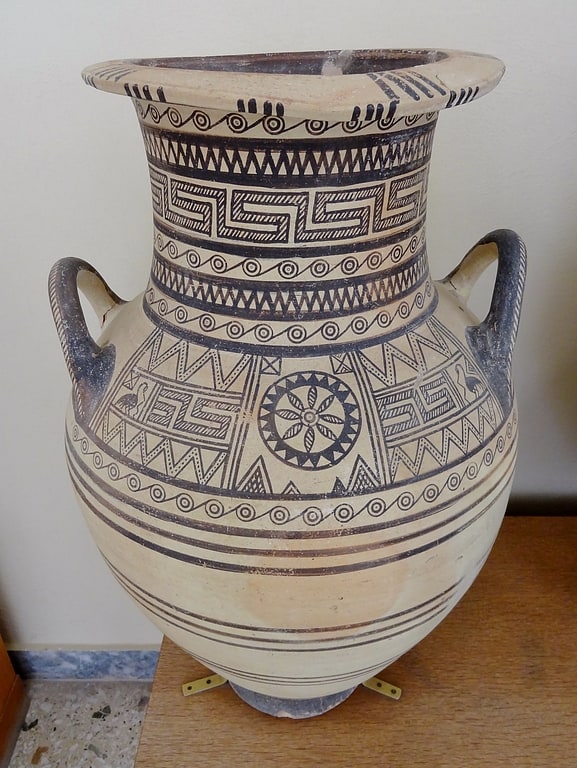
Archaeological museum with artifacts. The Archaeological Museum of Thera is a museum in Fira, Santorini, Greece. It was built in 1960 to replace an older one which had collapsed by the 1956 Amorgos earthquake.
Its collection houses artifacts that begin from Proto-Cycladic marble figurines of the 3rd millennium BC, and continue on to the Classical period.
There are prehistoric vases from Akrotiri dated to the 20th-17th centuries BC.
Later artifacts include pottery and amphorae of Geometric and Archaic periods. Many of these objects come from the ancient cemetery of Thera. One of them is a krater with Attic black figures from grave no. 1, with four ships on the internal surface, around the rim.
- Ancient ships 6th century BC
Address: Erithrou Stavrou, 847 00 Thira
Treasury of Atreus, Mycenae
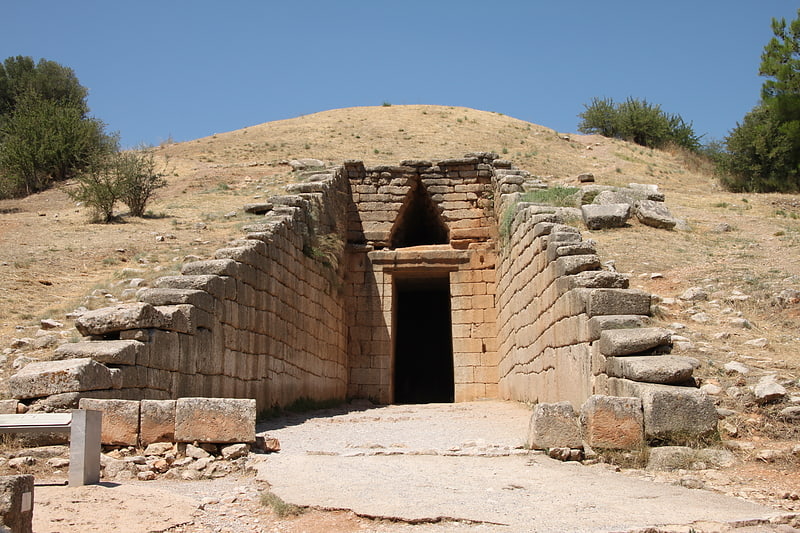
Historical landmark in Greece. The Treasury of Atreus or Tomb of Agamemnon is a large tholos or beehive tomb on Panagitsa Hill at Mycenae, Greece, constructed during the Bronze Age around 1250 BC. The stone lintel above the doorway weighs 120 tons, with approximate dimensions 8.3 x 5.2 x 1.2m, the largest in the world. The tomb was used for an unknown period. Mentioned by the Roman geographer Pausanias in the 2nd century AD, it was still visible in 1879 when the German archaeologist Heinrich Schliemann discovered the shaft graves under the "agora" in the Acropolis at Mycenae.
The tomb perhaps held the remains of the sovereign who completed the reconstruction of the fortress or one of his successors. The grave is in the style of the other tholoi of Mycenaean Greece, of which there are nine in total around the citadel of Mycenae and many more in the Argolid. However, in its monumental shape and grandeur it is one of the most impressive monuments surviving from the Mycenaean period.
The tomb has probably no relationship with either Atreus or Agamemnon – legendary rulers of Mycenae or Argos in the works of Homer, in the Epic Cycle, and the Oresteia – as archaeologists believe that the Mycenaean sovereign buried there ruled at an earlier date than the king; it was named thus by Heinrich Schliemann and the name has been used ever since. The historicity of the Trojan War, to which Schliemann sought to connect both Mycenae and Hisarlik, is a matter of long-standing and ongoing debate.[43]
Address: Θολωτός τάφος του Ατρέως, Mycenae
Santorini caldera, Santorini

Also known as: Καλδέρα Σαντορίνης
Volcanic crater in a picturesque setting. Santorini caldera is a large, mostly submerged caldera, located in the southern Aegean Sea, 120 kilometers north of Crete in Greece. Visible above water is the circular Santorini island group, consisting of Santorini, the main island, Therasia and Aspronisi at the periphery, and the Kameni islands at the center. It has been designated a Decade Volcano.[44]
Prodromos, Mount Athos
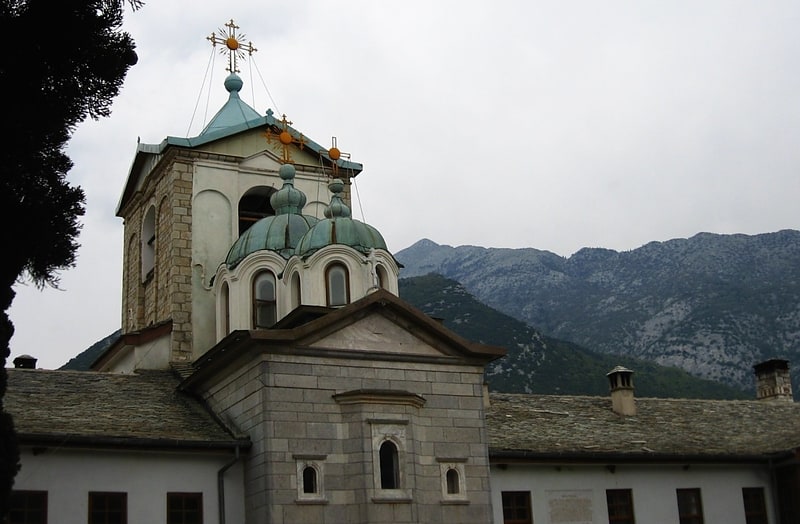
Also known as: Σκήτη Τιμίου Προδρόμου Μεγίστης Λαύρας
Monastery in Holy Skete of Saint John the Forerunner, Greece. The Romanian Skete Prodromos is a Romanian cenobitic skete belonging to the Great Lavra Monastery, located in the eastern extremity of the Eastern Orthodox Monastic State of the Holy Mountain Athos, between the Aegean Sea in the East and the peak of Athos rising 2033 m in the West, nearby the cave of Athanasios the Athonite. Its name, Prodromos, is the Greek for "The Forerunner", a cognomen of St. John the Baptist.
It is one of the two Romanian establishments on the Mountain, the other one being Lakkoskiti.
Spiritually, through its mother monastery, and like all the Athos peninsula, it is under the jurisdiction of the Ecumenical Patriarchate of Constantinople. Currently, 25 monks live there.[45]